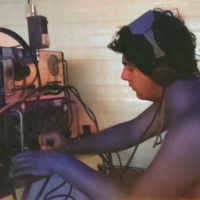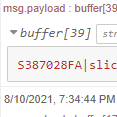SmartSDR v4.1.3 | SmartSDR v4.1.3 Release Notes
SmartSDR v3.10.15 | SmartSDR v3.10.15 Release Notes
The latest 4O3A Genius Product Software and Firmware
Need technical support from FlexRadio? It's as simple as Creating a HelpDesk ticket.
CAT commands and Com Port redirecting
I'm trying for my first time to send commands to my radio from a USB connected Teensy 4.1using CAT commands. I want communications from the Teensy only over a single USB-assigned COM port. In my case, COM14. I have virtual port COM5 assigned to the radio via SmartSDR CAT. I obviously have to redirect incoming COM 14 data commands to COM5 in the PC.
I have a Python redirector script that is working fine for me, but I wonder if there's a better, less awkward way? I've looked into com0com and even com2tcp, but I wonder what others may be using?
Fred, K9SO
Comments
-
Hi Fred, I have not tried any CAT commands with the Teensy 4.1, but I have done a lot with it using the TCP API commands. I'm not 100% sure this is the right thing, but wouldn't you use "Existing" to define a hardware port that you are connecting to?
Out of curiosity, why CAT instead of the API? The CAT commands are very limited in what they can do compared to the API.
0 -
-
Hi Len,
No, that doesn't work. The Teensy needs COM14 to communicate with the PC. If I set up COM 14 for the Flex communications too, I'm double dipping and SMartSDR won't be able to access that port during setup. For now, I'm going to stick with the Python script for redirection to continue progress on the project … at least until I find something more elegant.
I want to make a small "FlexControl" on steroids. I have a couple of Maestros, but 99% of the time I use them in SmartControl mode where the display is off. So I don't need a display. Lots of CAT commands.
Besides, with USB, I can have a single cable connected to the PC that transfers data and provides all the power I need. No extra power supplies, no wall warts, no Ethernet cables. For me at least, simpler.
73,
Fred K9SO
0 -
Just as a reminder, the Teensy has also a USB host port and 4 serial TTL ports.
Maybe an internal serial redirector…?0 -
I need to interface to a SmartSDR CAT serial port. That means the COM port redirector must reside in the PC, not in the Teensy. I can't think of another way.
Fred, K9SO
0 -
Teensy ←→ TTL or USB Adapter ←→ SmartSDR on Existing (virtual) port as suggested by Len.
This way you have 2 serial ports controlled by the Teensy. If the Teensy primary port is busy because the computer is using it (doing what?) you need a second port, this 'should' be true if you use a software redirector as well.
Or maybe I'm missing something…
Max
0 -
as N5NHJ stated, VSPE allows you to bridge two com ports.
As Len stated, if the Teensy shows as Com 14 and no software on PC is talking to the Teensy, then in SSDR CAT choose com14 and existing port. Key is no software on PC connected.
A third thought for operating at radio, if Teensy’s USB connection uses FTDI chipset, you might be able to plug it into the radio’s USB and define in USB cable setup in SmartSDR which to have follow the CAT commands (active slice, TX, A, B, etc). If worried about current draw, use a powered USB 2.0 hub.Dave wo2x
0 -
Thanks for all the comments.
My original question about COM port redirecting,
"I wonder what others may be using?"
has been answered. Apparently, VSPE is the preferred answer. I have used com0com in the past for this very same application. I'll look at VSPE. For now, I'm using a Python script I wrote that does the same thing.
This is a remote application so the radio USB port is not an option. The Teensy's primary port is being used for CAT command communications to the controlling PC at all times. This data must somehow be transferred to a SmartSDR CAT port in order to communicate to the radio and to do that, I'm using a redirector script running on the PC to do that.
Dave and Len, regarding the use of an existing port in SmartSDR CAT setup, I tried to set the same PC port (14) for CAT ( using existing), but it is in constant use by the Teensy to receive the commands. I don't know how to use the same PC port to do two different things (receive commands from Teensy and send to radio).
If I'm missing something obvious here, please let me know.
Fred, K9SO
0 -
I guess you only have one connection to PC and not two.
When you plug the Teensy into the PC it is via USB com14? What on PC need to communicate with Teensy except your Python script? Stop Python and try it.
73 Dave
0 -
Thanks for the lead Max,
I successfully created a COM14==COM5 bridge in VSPE and that seems to be working. I'll use that going forward. Much more intuitive than the other approaches. Press ON !
Fred, K9SO
0 -
After I get everything working, I discover that none of the published VFO B related CAT commands are recognized by the radio. Is there a radio setting I'm missing? All the VFO B settings return '?' even with VFO defined in SmartSDR.
0 -
the CAT port can be changed from slice A to other choices such as active slice or TX slice.
You cannot send slice A and B info through one CAT port. That is why the TCP API is the way to go. No bridge or redirects, and a whole lot more can be done.73 Dave wo2x
0 -
Part of the reason is the dynamics of the Flex SmartSDR design. Slices are not directly related to VFO A and B on traditional radios. The models that support 4 or 8 slices would not be able to use CAT if it were slaved as Slice A were to be VFO A and slice B were VFO B.
In a dual SCU radio such as a 6600 or 8600, a slice can use SCU 1 or 2 and the TX port for a slice can be ANT 1 or 2 or any transverter or RX port.I use Node Red to communicate to the radio via the API. The Node Red server resides on the radio network.
Len has done a lot with the API and his Teensy project. Maybe that could help you as far as the API commands?1 -
I was hesitant to use the API over TCP at first, but once I got rolling, it became obvious that the API is infinitely better than CAT. My guess is that CAT is there to support third party apps that only have a CAT interface.
Another advantage of the API to consider is that it can be used remotely. I connect my TeensyMaestro remotely using the SoftEther VPN.
0 -
Dave,
I get that, but I haven't given up yet. How is FlexControl doing it? Is there an API control via USB? USB gives me power and a single cord. No extra cables, no extra power supplies. I don't want to control everything, just A and B frequencies, AF gain, and AGC-t settings. Maybe power level.
With CAT, apparently you can set up split mode with ZZSW1; command. That starts a second flag (VFO) B that can be controlled by the CAT commands for VFO B. But unless you set up the B flag using ZZSW1, it seems you can't CAT control VFO B functions from any B flag setup using SmartSDR. Surprising.
Fred, K9SO
0 -
SmartSDR CAT can be used remotely. If your client can connect remotely to the radio then SmartSDR CAT will control the radio. I use an Arduino Nano Every that sends CAT control for MOX. This allows me to have a remote foot switch PTT.
0 -
Very true Mick, I forgot about that.
0 -
Fred,
Just because you are mentioning the FlexControl, did you check what is the device sending?
I don't see any CAT string coming from the FlexControl. It's interaction with the radio is embedded in SmartSDR.
0 -
K9SO
I Flex world, every slice is VFO-A.
However, in Flex CAT, each slice has a unique COM port number, or in my case using TCP, has a unique TCP:port.
So, if you want slice B to be VFO-B, just send the VFO-A Kenwood command to the CAT port for slice B.
I my case, I am interfacing with a third part program that uses the VFO-B keen wood commands, so I need to filter these out, change to VFO-A format, and send to the CAT port for slice B.
Clear as mud.
Alan. WA9WUD
0 -
Alan ,
I assume you are referring to the commands below…
ZZFA Reads / Sets VFO A Frequency (11 digit Hz)
ZZFB Reads / Sets VFO B Frequency (11 digit Hz)
0 -
Mick
Yes.
In Node-Red, I wrote a function to look for a REGEX "contains", "FB", and translated that to "FA", attach the frequency or what ever, then send to a Flex CAT TCP Slice B Slice.
Alan. WA9WUD
1 -
The CAT commands can act very strangely. For example, the command ZZFA; will read A slices correctly over COM ports set up for slice A, but if using the same slice A COM port, the command ZZFB; will not read slice B unless the slice was specifically set up using the ZZSW1; command. It will not read B slices that were set up using smartSDR. But a B slice set up with ZZSW1; and queried with ZZFA; will read slice B even though the COM port is for slice A.
So the obvious solution as Alan has said is to set up two PC COM ports, one for each slice. But since my PC is receiving data from a single Teensy port and not from an internal program like Node Red, I had to append a prefix A for A slice commands and a B for B slice commands. Then in my Python script, I **** off the prefixes and bridge to the correct slice port. Then the ZZFA; command on the B slice comport will read slice B! Go figger.
You also have to be careful with ZZFA; commands. If you ever send ZZFA<11 digits>; the radio will respond with 11 digits for all future inquiries. But if you send ZZFA<8 digits>; , it reverts back to sending responses in 8 digit format.
Convoluted and often confusing when using CAT, but it is working.
Fred, K9SO
1 -
what about setting SmartSDR CAT port to Active Slice or TX Slice instead of slice A or B? Then whatever slice is active (yellow stripe) will be controlled by CAT commands and will sends that slice’s frequency and mode when sent an FA; or FB;
Dave wo2x
0 -
Hi Dave,
I don't understand. I don't see that as an option, even in advanced. Only A B C or D. How would I do that?
Fred, K9SO
0 -
hi Fred,
I was thinking of the USB port on the back of the radio.
I was helping a customer with questions on USB cables.I still suggest checking what would be required to migrate to the API, or separate connections from Teensy to computer so you could have A and B but how would you handle slices C and D?
73 Dave wo2x
0 -
Thanks Dave, I'm nowhere near the radio for this application so I only have the PC and Teensy to work with. ☺️
I do have all this working in CAT now, but I have had to assign a smartSDR CAT port to each slice. So as Alan pointed out, if you send the 'A' commands (e.g., 'FA;') to the 'B' port, it will control the 'B' slice. I'm assuming I can do the same for C and D slices.
But in order to do this, I have to run a bridging Python script on the PC.
73, Fred K9SO
0 -
I am not familiar with the Teensy. Does it have network capability?
Can your Teensy send CAT out to a TCP IP? If so, how about writing your Teensy script to send FA; for slice A to PC IP and port 3456 where you define 3456 as a TCP CAT port for slice A in SmartSDR CAT.
Then do same for slice B, C, D but different ports which you can define in SSDR CAT.
Your Teensy would need to look at the responses from each port and process accordingly.That would allow control of each slice. Just a thought.
73 Dave wo2x
0 -
Yes, the 4.1 has Ethernet capability, but I'm still looking for that one connection cord that will also supply power to my device. However, you did point out something I've been overlooking.
As long as I'm running a Python program on the PC anyway, I guess I can translate USB serial commands to API codes on a CAT TCP port 4992. That puts a strain on my Python skills, but I'm in this for learning anyway. It's really not too much different an approach than what I have working now using the CAT commands but admittedly, there are many more knobs available.
If I end up going that way, all of you can line up and say "I told you so!"
73, Fred K9SO
0
Leave a Comment
Categories
- All Categories
- 379 Community Topics
- 2.1K New Ideas
- 631 The Flea Market
- 8.2K Software
- 120 SmartSDR+
- 6.4K SmartSDR for Windows
- 183 SmartSDR for Maestro and M models
- 430 SmartSDR for Mac
- 271 SmartSDR for iOS
- 259 SmartSDR CAT
- 193 DAX
- 382 SmartSDR API
- 9.3K Radios and Accessories
- 38 Aurora
- 261 FLEX-8000 Signature Series
- 7.2K FLEX-6000 Signature Series
- 947 Maestro
- 56 FlexControl
- 866 FLEX Series (Legacy) Radios
- 924 Genius Products
- 463 Power Genius XL Amplifier
- 336 Tuner Genius XL
- 125 Antenna Genius
- 297 Shack Infrastructure
- 209 Networking
- 460 Remote Operation (SmartLink)
- 144 Contesting
- 787 Peripherals & Station Integration
- 139 Amateur Radio Interests
- 1K Third-Party Software






